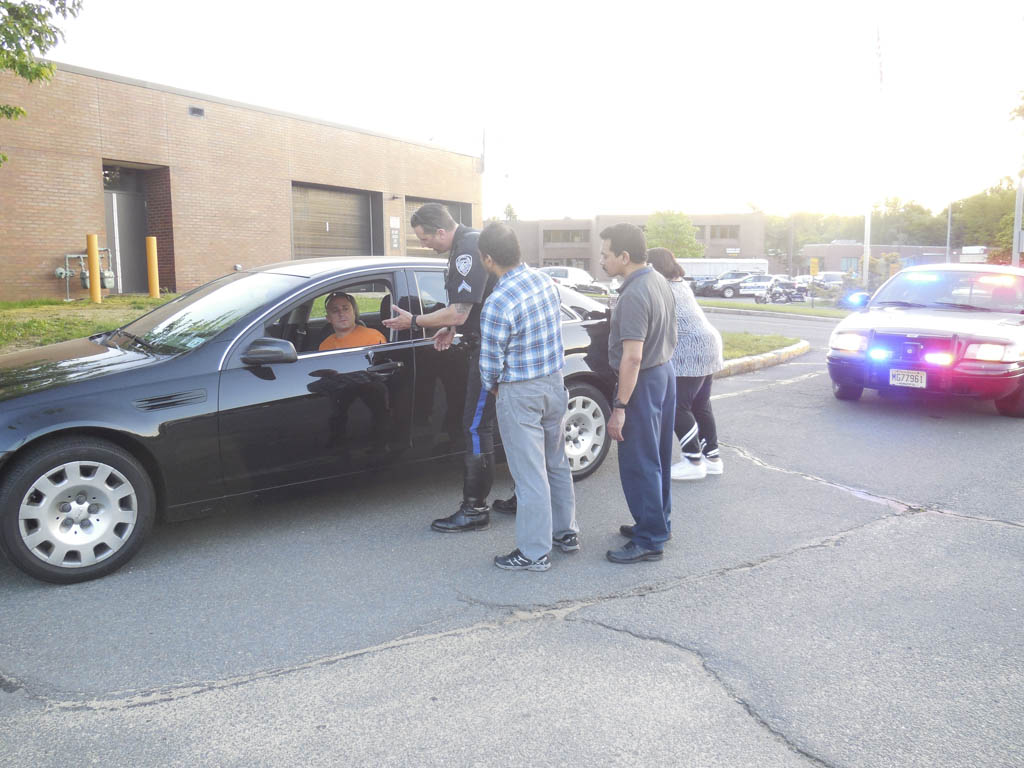By JENNIFER AMATO
Staff Writer
SOUTH BRUNSWICK – Upon walking into the room, the tension was palpable.
The wife was standing up, screaming in her husband’s face. She wouldn’t listen to him explain that he just had a difficult day at work and needed some downtime. She continued her antics, yelling in a nasty tone, not paying attention to her son who was listening nearby. She cut her husband with a knife, causing a several-inch slit down the inside of his forearm.
Three police officers arrived on scene to try to control the situation. They tried to get the information from the husband, calm the wife down and eventually locate the 12-year-old boy, who had called 911.
This domestic violence scenario was one of five presented during the practicals for the South Brunswick Citizen Police Academy, which culminated 11 weeks of instructional lessons on May 16 with hands-on portrayals of real-life situations law enforcement officers encounter on a daily basis.
“We have to stop the fear,” Sgt. Tara Jairdullo, lead instructor, said of exposing residents to the innerworkings of police work. “It’s great to be with the community.”
With EMTS Joe Christian as the husband and Jessica Klein as the wife, and with Matthew Ryan acting as the young son, the 15 civilian cadets were able to experience a high-intensity situation.
Officer Mike Urstadt instructed the cadets, in groups of three, on how to handle the situation: separate the couple, handcuff the woman for causing visible injuries, secure the weapon and find the child who called the police.
“The child is a piece of evidence,” Urstadt said. “If he’s old enough to call 911, he’s old enough to be a witness.”
Another scenario focusing on witness identification and evidence collection was led by Detective Monica Shearer. She was discussing information on phone scammers when a gentleman walked into the training room and asked where the bathroom was. Little did the cadets know, the officer was in on the act, presenting himself for just a few moments to see how much witness information the adult observers would be able to compile.
The group formulated a list with words such as white, male, glasses, tan shirt, tan shorts, medium build, 6-feet 2-inches and wearing a cap. Once he walked back into the room, the students noticed they had varying accounts of what they thought they saw.
“We go to a scene and collect evidence, talk to witnesses and recreate the best story we can,” Shearer said, with Jairdullo reinforcing how witnesses perceive things differently based on their internal perceptions, their stress level at the time, their involvement in the incident, their focus, etc.
Jairdullo said it is important for people to always be observant. She said one of the most important pieces of evidence is a license plate, especially if a bystander can write it down or take a picture. Shearer also said unique characteristics such as an accent or lisp, or a tattoo or scars, are helpful in police collecting information on their suspect(s).
In another role-playing situation, the citizens were asked to perform a routine traffic stop. Officer Frank Mongalieri informed the group that traffic stops can be one of the most dangerous situations an officer faces. He showed the cadets how to park a patrol car on the side of a highway, how to use the radio to call dispatch, how to approach the vehicle in question and how to approach the driver.
“You have to be clear, fast, authoritative, but friendly,” he said.
He said that an officer’s role is to take control of the situation, but not to argue with the driver or become aggressive.
“When stuff goes wrong, it goes wrong fast,” Mongalieri said. “You can’t second-guess yourself. Your training and experience has to kick in.”
There was also a room-clearing scenario led by Officer Jay Jairdullo in which the cadets had to examine a dark room with a door open, where a suspect was hiding.
Cadets also went on a simulated first aid call.
The Citizen Police Academy was held for years until 2010. Chief Raymond Hayducka reinstated it in 2015, with Tara Jairdullo and Julie Trammell, the secretary for Support Services, at the helm.
Cadet Keshant Kansara said he believes the academy teaches citizens how the police operate and how they help each other in the community.
“You have to be more aware and talk to your friends and family,” he said, “and help them not to do something wrong.”
He said he did not mind the three hours of lessons every Tuesday night because all of the lessons “were interesting” and “all of the officers are fantastic.”
“The police cannot be everywhere. It’s a big town. … You have to spread awareness of what is good and bad,” Kansara said. “For the community, living in the community, you need to help each other.”
A graduation ceremony for the Civilian Police Academy was planned for May 23.
Contact Jennifer Amato at [email protected].

